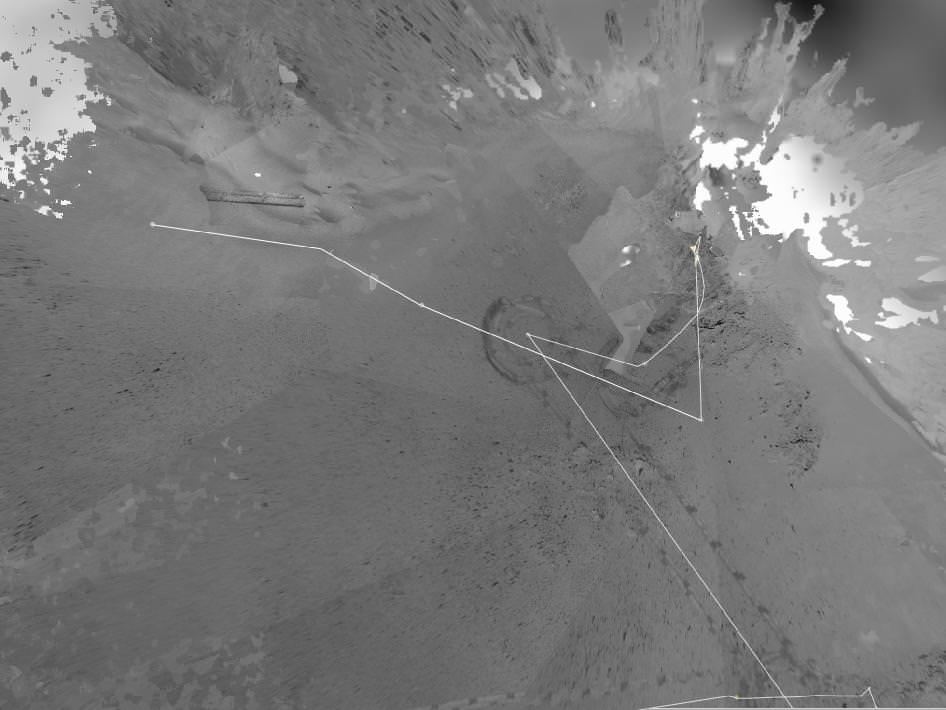[/caption]
After spending 19 weeks working in one place during the Martian winter in Meridian Planum, the Opportunity Mars rover is now roving once again. During the winter, available solar power was too low for driving, but on May 8th (here on Earth), Opportunity took its first drive since Dec. 26, 2011. She drove about 3.67 meters (12 feet) northwest and downhill.
“We’re off the Greeley Haven outcrop onto the sand just below it,” said rover driver Ashley Stroupe of JPL. “It feels good to be on the move again.”
During the period while the rover was stationary, she wasn’t just sleeping. Engineers sent commands for Oppy to use the spectrometers and microscopic imager on its robotic arm to inspect more than a dozen targets within reach on the outcrop. Radio Doppler signals from the stationary rover during the winter months served an investigation of the interior of Mars by providing precise information about the planet’s rotation, a study that scientists were hoping to do with the Spirit rover, but unfortunately she fell silent before they could do the experiment.

So how is Opportunity’s power supply? As long as the rover stays tilted northward towards the Sun – about 8 degrees is all that’s needed – she will have sufficient power to take short drives.
But unless wind removes some dust from her solar arrays, allowing more sunlight to reach the solar cells, the rover will need to work during the next few weeks at locations with no southward slope. “We’ll head south as soon as power levels are adequate to handle the slopes where we’ll go,” said Mars Exploration Rover Deputy Project Scientist Diana Blaney of JPL.
“Our next goal is a few meters farther north on Cape York, at a bright-looking patch of what may be dust,” said Opportunity science-team member Matt Golombek of JPL. “We haven’t been able to see much dust in Meridiani. This could be a chance to learn more about it.”
Beyond the dust patch, the team intends to use Opportunity to study veins in bedrock around the northern edge of Cape York. A vein inspected before winter contained gypsum deposited long ago by mineral-laden water flowing through a crack in the rock.
As you remember, Opportunity has been going strong for over 9 years now, exploring the Meridiani region of Mars since landing in January 2004. It arrived at the Cape York section of the rim of Endeavour Crater in August 2011, and has been studying rock and soil targets on Cape York since then.


my neighbor’s mom makes $86/hour on the laptop. She has been without work for seven months but last month her income was $16983 just working on the laptop for a few hours. Here’s the site to read more ?????? http://Makecash11.blogspot.com
Spammer Please Flag !!!!Spammer Please Flag !!!!dsfdfsdSpammer Please Flag !!!!Spammer Please Flag !!!!
9 years, most people don’ t have cars that old! NASA knows how to build em.
Question? Since the solar panels are always in dangter of getting coated with dust, did anyone designing future missions ever think to have the panels on hinges with a motor to raise them near vertical so the dust could slough off? Or is there static electrical forces to prevent the dust from sliding off?
Answer!?
These rover’s design criteria didn’t include mitigating solar panel power decline from accumulating dust and electrical damages. (As the surface oxidizing agents witness, the thin atmosphere doesn’t do much to protect from UV and cosmic radiation damage.) A projected 90 days nominal mission couldn’t support efforts in that direction.
And the next US rover, Curiosity, is nuclear powered so this isn’t a design concern.
The next rover over [sic], the ESA ExoMars mission launching in 2016, could do with dust mitigation. But I think it goes without, it is the first ESA rover and have other more serious concerns to labor under. Weight penalty being a major one.
There seems to be projects looking on this though. Luckily, a major driver for electrostatic dust mitigation is solar panel technology in general:
“The technology was developed for future rover missions to Mars, but it could work here on Earth to keep solar panels operating at peak capacity. It uses electrostatic charge to repel dust and force it to the edges of the panels. It can remove 90 percent of the dust on a solar panel in a two-minute cycle, says Malay Mazumder, a research professor at Boston University who led the work. “
Here’s to hoping for turning the wheels for another year.
This is one good reason why, besides looking for the Endeavour upcast clays and its stratigraphy down the crater. As I understand it, the chances that one winter’s worth of observations will uncover whether Mars core is still liquid (so likely an active mantle) are virtually nil. The next winter should, however, be enough.